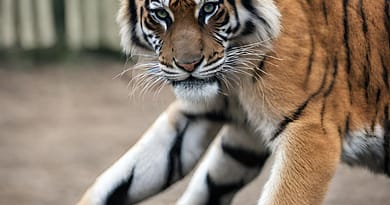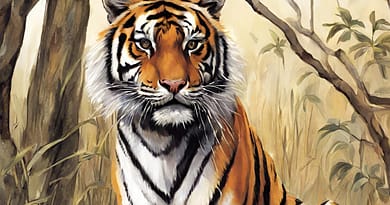What Animals Do Siberian Tigers Eat? A Guide to the Diet of the World’s Largest Cat
If you are fascinated by the majestic Siberian tiger, you might wonder what kind of prey it hunts in the wild. The Siberian tiger, also known as the Amur tiger, is the largest subspecies of tiger and one of the biggest predators on Earth. It lives in the cold and snowy regions of Russia, China, and North Korea, where it faces many challenges to survive and thrive.
In this article, we will explore the diet of the Siberian tiger, what factors influence its food choices, how it adapts to its harsh environment, and what threats it faces from human activities. We will also answer some frequently asked questions about the Siberian tiger and its eating habits.
What Does a Siberian Tiger Eat?
The Siberian tiger is a carnivore, meaning it only eats meat. It is an apex predator, meaning it has no natural enemies except humans. It can hunt and kill animals that are much larger and heavier than itself, such as deer, elk, moose, wild boar, and even bears.
The Siberian tiger prefers to hunt large ungulates (hoofed mammals) that provide enough calories and nutrients for its massive body. According to a study by Kerley et al. (2002), the most common prey species for the Siberian tiger in Russia are:
– Wild boar (29.6% of kills)
– Red deer (26.8% of kills)
– Roe deer (16.2% of kills)
– Sika deer (9.1% of kills)
– Moose (7.7% of kills)
– Musk deer (4.6% of kills)
– Goral (3.4% of kills)
– Other species (2.6% of kills)
The average weight of the prey killed by the Siberian tiger is 209 kg (461 lbs), which is more than twice the weight of the tiger itself. The largest prey ever recorded was a 550 kg (1212 lbs) adult male moose.
The Siberian tiger can eat up to 50 kg (110 lbs) of meat in one sitting, but it usually consumes about 10 kg (22 lbs) per day on average. It can go several days without eating if necessary, but it will lose weight and strength over time.
How Does a Siberian Tiger Hunt?
The Siberian tiger is a solitary hunter, meaning it hunts alone and does not share its food with other tigers. It relies on its excellent vision, hearing, and sense of smell to locate and track its prey. It also uses camouflage to blend in with its surroundings and avoid detection.
The Siberian tiger usually hunts at night or during dawn and dusk, when its prey is more active and less alert. It stalks its prey stealthily, keeping a low profile and using cover such as trees, bushes, rocks, or snow. It can move silently and swiftly, reaching speeds of up to 80 km/h (50 mph).
When the Siberian tiger is close enough to its prey, it launches a powerful attack, aiming for the neck or throat of the animal. It uses its sharp teeth and claws to inflict fatal wounds and suffocate its victim. It can kill an animal with a single bite or swipe.
The Siberian tiger then drags its prey to a secluded spot where it can eat in peace. It may cover its kill with leaves or snow to hide it from scavengers such as wolves or eagles. It may return to the same kill several times until it is finished or spoiled.
How Does a Siberian Tiger Adapt to Its Environment?
The Siberian tiger lives in one of the most extreme environments on Earth, where temperatures can drop below -40°C (-40°F) and snow can reach up to 1 m (3 ft) deep. To survive in these conditions, the Siberian tiger has developed several adaptations that make it well-suited for its habitat.
Some of these adaptations are:
Thick fur: The Siberian tiger has a thick coat of fur that insulates it from the cold and protects it from frostbite. Its fur is also longer and paler than that of other tigers, which helps it blend in with the snow.
Large paws: The Siberian tiger has large paws that act like snowshoes, spreading its weight over a larger surface area and preventing it from sinking into the snow. Its paws also have sharp claws that help it grip the ice and catch slippery prey.
Fat reserves: The Siberian tiger has a layer of fat under its skin that provides extra insulation and energy. Its fat reserves can account for up to 20% of its body weight in winter.
Long tail: The Siberian tiger has a long tail that helps it balance on uneven terrain and steer while running. Its tail also serves as a scarf that wraps around its face and neck when it sleeps, keeping it warm and cozy.
Strong muscles: The Siberian tiger has strong muscles that give it the strength and endurance to hunt large prey and survive in harsh conditions. Its muscles also generate heat, which keeps its body temperature stable.
What Threats Does a Siberian Tiger Face?
The Siberian tiger is an endangered species, meaning it is at risk of extinction in the wild. According to the International Union for Conservation of Nature (IUCN), there are only about 500 to 600 Siberian tigers left in the world, most of them in Russia.
The main threats to the Siberian tiger are:
Habitat loss: The Siberian tiger’s habitat is shrinking due to deforestation, logging, mining, agriculture, and human development. This reduces the amount of space and resources available for the tiger and its prey, forcing it to compete with other predators or move into areas where it may encounter humans.
Poaching: The Siberian tiger is hunted illegally for its fur, bones, teeth, claws, and other body parts, which are used in traditional medicine or sold as trophies. Poaching not only reduces the population size of the tiger but also disrupts its social structure and genetic diversity.
Human-wildlife conflict: The Siberian tiger may come into conflict with humans when it preys on livestock or domestic animals or wanders into villages or towns. This may result in retaliatory killings by farmers or villagers or capture and relocation by authorities.
Climate change: The Siberian tiger’s habitat is affected by climate change, which may alter the availability and distribution of food and water, increase the frequency and intensity of fires and floods, and facilitate the spread of diseases and parasites.
What Can We Do to Save the Siberian Tiger?
The Siberian tiger is a vital part of the ecosystem and a symbol of beauty and power. It deserves our respect and protection. There are several actions that we can take to help save the Siberian tiger from extinction, such as:
1) Supporting conservation organizations that work to protect the Siberian tiger and its habitat, such as the World Wildlife Fund (WWF), the Wildlife Conservation Society (WCS), or the Amur Tiger Conservation Project (ATCP).
2) Raising awareness and educating others about the plight of the Siberian tiger and the importance of biodiversity, such as by sharing information on social media, joining campaigns, or signing petitions.
3) Reducing our environmental impact and carbon footprint, such as by using renewable energy sources, recycling waste, or planting trees.
4) Avoiding products that contain tiger parts or derivatives, such as fur coats, rugs, medicines, or ornaments. Buying these products fuels the illegal trade and poaching of tigers.
5) Reporting any suspicious activities or sightings of tigers or their parts to the authorities or conservation groups.
FAQs
Q: How big is a Siberian tiger?
A: The Siberian tiger is the largest subspecies of tiger and one of the biggest cats in the world. It can grow up to 3.3 m (10.8 ft) long from head to tail and weigh up to 300 kg (660 lbs).
Q: How long does a Siberian tiger live?
A: The Siberian tiger can live up to 15 years in the wild and up to 25 years in captivity.
Q: How many cubs does a Siberian tiger have?
A: The Siberian tiger usually has two to four cubs per litter, but it can have up to six. The cubs are born blind and helpless, and they depend on their mother for food and protection until they are about 18 months old.
Q: How fast can a Siberian tiger run?
A: The Siberian tiger can run up to 80 km/h (50 mph) for short distances, but it prefers to ambush its prey rather than chase it.
Q: How do you tell a male from a female Siberian tiger?
A: The male Siberian tiger is larger and heavier than the female. It also has a thicker mane around its neck and cheeks.
Conclusion
The Siberian tiger is a magnificent animal that has adapted to live in one of the most challenging environments on Earth. It is an expert hunter that can kill prey much larger than itself. However, it is also an endangered species that faces many threats from human activities. We need to act now to save this majestic creature before it is too late.
Further Reading:
-> Fascinating Facts About Siberian Tigers









